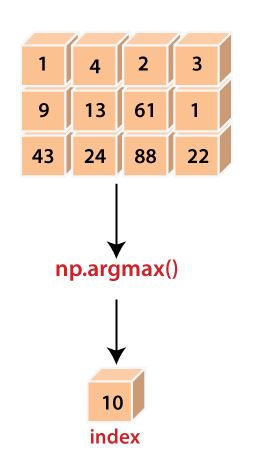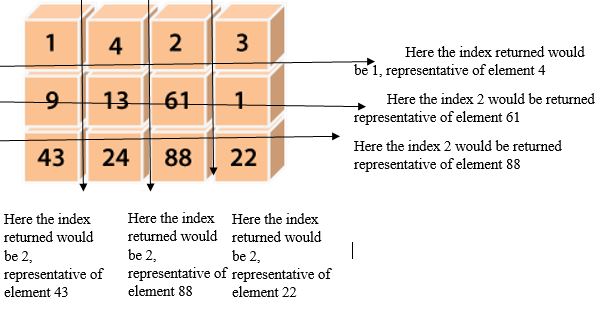Updated April 1, 2023
Introduction to NumPy.argmax()
Numpy.argmax() function is used in the Python coding language in order for the system to return the indices of the elements which phase out to be the largest value. This is done with respect to the specified axis defined by the user of the court. In case the axis is not defined in a multidimensional array, then the default access is taken by the system. The function generally flattens the arrays into a linear value chain containing elements in the absence of a axis being mentioned sorting a single largest element from all the contents in the array.
Syntax and parameters
Following is the syntax in which the numpy.argmax() is written in the Python programming language:
numpy.argmax(a, axis=None, out=None)Parameters:
Following is the parameters used for the numpy.argmax() function written in the Python programming language:
- Parameters: a1 : array_like
The array which has been entered by the user to seek through the maximum element amongst them - axis : integer
The axis numeral which is to be selected for performing the argmax function. The default value for the function is performed over flatting the array in linear form if the specific axis is not specified by the user. - output : array value retuned
If the parameter is mentioned in the syntax specified then the function after being performed by the system would be inserted in an array ‘output’ This array has to be of the same dimensions and dtype, as that of the original array inserted - Returns: index_array : ndarray of ints
The output obtained after performing the function argmax(). This resultant array contains the indices of the maximum values element’s representative index number. This resultant array is hat of the same dimensions and shape of that of the array a1, but with the dimensions along the specified axis being removed as an exception.
How does the NumPy.argmax () work?
The argmax function works in a way that when the system requires its need, at first scan through the array presented to it and tries to identify if any index has been specified by the user. In case no axis is specified, the system computes that the complete array has to be used for processing the elements.
Next, the system compares every individual element which is present in the array and identifies the largest element amongst them. This element is not directly produced to the user. Rather, the system captures the index number representative of the memory section within the computer system where this element has been encrypted in.
Whenever the user calls to print the output for the given program, the index number is called upon and printed on the screen, representing the position of the element in the array.
Therefore, for each axis a different element might be opted out displaying the largest number. For instance:
Here the largest element is 88, which will have a representative index number 10 which would be displayed by the system. For the 0th axis, the number 43 is the largest and hence index 3 would be returned.
Examples to Implement NumPy.argmax() in Python
Here are the examples mentioned:
Example #1
Code:
# A program written using the python language used to illustrate the function argmax()
import numpy as n1
# The program is shown to work on a two dimensional array
a1 = n1.arange(12).reshape(3, 4)
print("ENTER THE ARRAY TO BE ENTERED BY THE USER : ", a1)
# Performing the function by not specifying any axis, hence whole array to be used
print("The largest element is: ", n1.argmax(a1))
# Performing the function by specifying particular axis (here 0 and 1)
print ("THE OUTPUT IS:" )
print("The representative indices of the largest element for 0th Axis is : ", n1.argmax(a1, axis=0))
print("The representative indices of the largest element for 0th Axis is : ", n1.argmax(a1, axis=1))Output:
Example #2
Code:
# A program written using the python language used to illustrate the function argmax()
import numpy as n1
# The program is shown to work on a two dimensional array
a1 = n1.random.randint(6, size=(4, 4))
print("ENTER THE ARRAY TO BE ENTERED BY THE USER : ", a1)
# Performing the function by not specifying any axis, hence whole array to be used
print("The largest element is: ", n1.argmax(a1))
# the program is used for returning Indices representing the largest element
# Performing the function by specifying particular axis (here 0 and 1)
print ("THE OUTPUT IS:" )
'''
[[ 0 30 80 130]
[120 110 20 110]
[ 50 130 80 30]
[120 150 30 40]]
^ ^ ^ ^
120 150 80 130 - element
1 3 0 0 - indices
'''
print("The representative indices of the largest element for 0th Axis is : ", n1.argmax(a1, axis=0))
''' ELEMENT INDEX
->[[ 0 30 80 130] 13 3
->[120 110 20 110] 12 0
->[ 50 130 80 30] 13 1
->[120 150 30 40]] 15 1
'''
print("The representative indices of the largest element for 1st Axis is : ", n1.argmax(a1, axis=1))Output:
Conclusion
The argmax() function is a very vital tool in the numerical python package that allows for using a prebuilt functionality for the seeking the index centred maximum value for arrays. It not only reduced the verbosity of the code being written but also reduces the strain being put on the overall memory of the system, by not storing data in multiple resultant arrays and being projected from the memory centred single storages which increases the processing capability of the system.
Recommended Articles
This is a guide to NumPy.argmax(). Here we discuss an introduction to NumPy.argmax(), Syntax, Parameters, How does it work and respective examples. You can also go through our other related articles to learn more –








